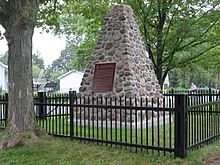Battle of Cook's Mills facts for kids
Quick facts for kids Battle of Cook's Mills |
|||||||
|---|---|---|---|---|---|---|---|
| Part of the War of 1812 | |||||||
 The monument commemorating the battle. |
|||||||
|
|||||||
| Belligerents | |||||||
| Commanders and leaders | |||||||
| Christopher Myers | George Izard Daniel Bissell |
||||||
| Strength | |||||||
| 750 1 cannon |
1,200 | ||||||
| Casualties and losses | |||||||
| 1 dead, 35 wounded |
12 dead, |
||||||
| Official name: Battle of Cook's Mills National Historic Site of Canada | |||||||
| Designated: | 1921 | ||||||
The Battle of Cook's Mills was an important fight during the War of 1812. It was the last major battle between American and British armies in the Niagara Peninsula area. The battle happened on October 19, 1814. American soldiers won this short fight. They managed to outsmart the British and destroy their food supplies.
Contents
Why the Battle Happened
The War of 1812 was still going on. A British general named Gordon Drummond had stopped attacking Fort Erie. He moved his soldiers to a strong defense spot at Fort Chippawa. Meanwhile, an American general, George Izard, arrived with more troops to help the Americans at Fort Erie.
General Izard took charge of all the American forces. Another American general, Jacob Brown, wanted to attack the British right away. But Izard thought it was too risky to attack such a strong British position. Because of this, General Brown left with half of the army. He went to Sackets Harbor, New York because they feared a British attack there.
General Izard then moved his remaining troops north towards Chippawa Creek. But the creek was too deep to cross, and the bridge was broken. For a day, his cannons fired at the British, but nothing much happened.
The Battle Begins
The American army wanted to cut off the British food supply. So, General Izard sent about 1,200 American soldiers to a place called Cooks Mills. This group included different infantry units and some riflemen and dragoons. Brigadier General Daniel Bissell led these troops. Their goal was to capture the mills and destroy the flour.
In response, the British general, Drummond, sent about 750 of his own soldiers. These included the 6th Regiment, the Glengarry Light Infantry, and parts of the 104th Regiment. They also had a cannon and some rockets. Lieutenant Colonel Christopher Myers was in charge of this British group. His job was to check out the American forces.
The Fight at Cooks Mills
On the morning of October 19, Colonel Myers' British troops met the American soldiers. The Americans were just east of the mills. A short fight lasted about half an hour. The British tried to get the Americans to come out into the open, but the Americans stayed hidden in the woods.
Colonel Myers saw American soldiers moving through the trees on his right side. He worried that his troops were about to be surrounded. So, he ordered a retreat. The Americans quickly chased the British soldiers almost all the way back to their camp.
After the British left, the Americans returned to Cooks Mills. They destroyed all the grain and flour they found there. The next day, the American troops went back to their own camp at Black Creek.
What Happened Next
This battle showed that General Izard's American troops were well-trained. Even though the Americans won this small victory, it became clear that the British general, Drummond, was not going to leave his strong defenses. Izard also learned that British ships controlled Lake Ontario. This meant that if the Americans pushed forward, they could be trapped by British landings behind them.
Because of this, General Izard decided to pull his troops back to Fort Erie. The British had a small win when some American supply boats accidentally crossed the Niagara River and were captured.
Later, Izard ordered Fort Erie to be destroyed. Then, he and his troops returned to the American side of the river. General Drummond moved to where the fort used to be, but he chose not to rebuild it. This marked the end of the fighting along the Niagara Frontier.
The place where the battle happened was named a National Historic Site of Canada in 1921.
Sources
- Heidler, David; Heidler, Jeanne, editors Encyclopedia of the War of 1812


